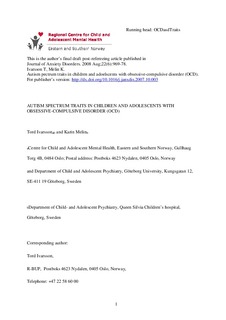| dc.description.abstract | Objective:
Assess the prevalence of autistic traits (AST) in pediatric obsessive-compulsive disorder (OCD) and relate them to OCD co-morbidity and compare them with published normative data.
Methods:
Pediatric patients with obsessive-compulsive disorder (n = 109) according to the DSM-IV were studied using parent ratings of the Autistic Symptom/Syndrome Questionnaire to assess AST symptoms as a continuous rather than categorical trait. The KSADS, a semi-structured psychiatric interview, was used for the psychiatric diagnostic evaluation. Also, the Children's Yale-Brown Obsessive-Compulsive Scale was used to assess OCD severity and other clinical features.
Results:
AST was common among our patients. Symptom scores were highest in cases with co-morbid Autistic Spectrum Disorders, but cases with other co-morbidities as tics/Tourette and attention/behavioral disorders also scored higher. All sub-groups, including OCD without these co-morbidities scored higher than the Swedish normative group. Using ANOVA, co-morbid ASD and tics/Tourette (plus a term for gender by tic interaction indicating that girls with tics scored high, otherwise low) and pathological doubt contributed (R2 = .41) to the AST-traits, while OCD severity and co-morbid anxiety- and depressive disorders did not.
Conclusion:
AST traits are prevalent in OCD and seem to be intricately associated with the co-morbidities as well as the OCD syndrome itself. The findings might have implication for our nosological understanding of OCD which currently is discussed. | |
